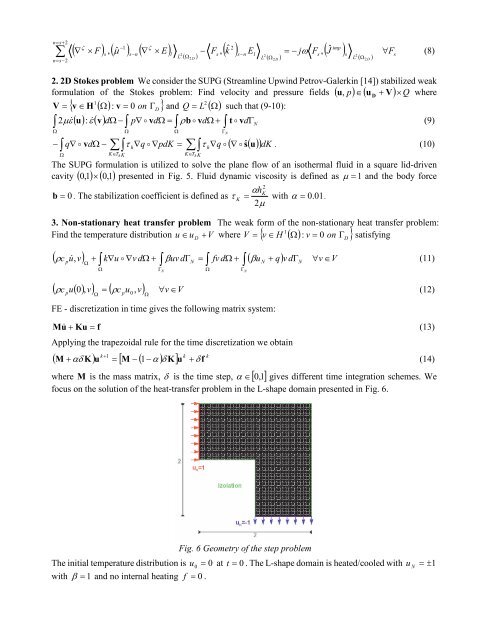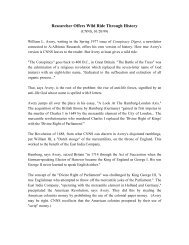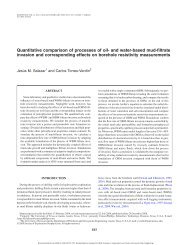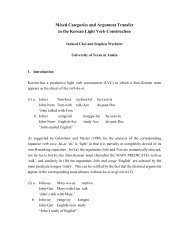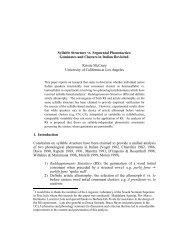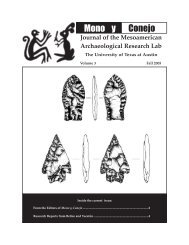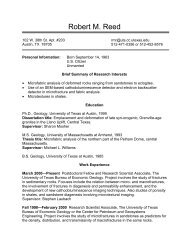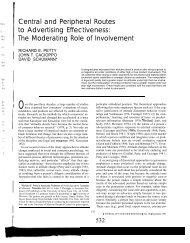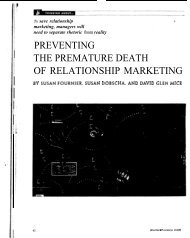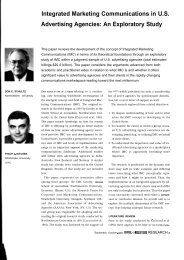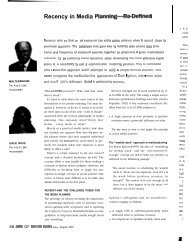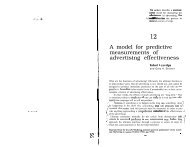APCOM'07 in conjunction with EPMESC XI, December 3-6, 2007 ...
APCOM'07 in conjunction with EPMESC XI, December 3-6, 2007 ...
APCOM'07 in conjunction with EPMESC XI, December 3-6, 2007 ...
Create successful ePaper yourself
Turn your PDF publications into a flip-book with our unique Google optimized e-Paper software.
ζ<br />
−1<br />
ζ<br />
imp<br />
( ∇ × F ) s ( ) s n ( ∇ × E)<br />
l − F ( ) ( ) L ( ) s kˆ<br />
2<br />
, ˆ µ −<br />
, s−n<br />
El<br />
= − jω<br />
Fs<br />
, Jˆ<br />
2<br />
Ω<br />
2<br />
s 2<br />
2 D<br />
L ( Ω ) L ( Ω )<br />
n=<br />
s+<br />
2<br />
∑<br />
n=<br />
s−2<br />
2 D<br />
2 D<br />
2. 2D Stokes problem We consider the SUPG (Streaml<strong>in</strong>e Upw<strong>in</strong>d Petrov-Galerk<strong>in</strong> [14]) stabilized weak<br />
formulation of the Stokes problem: F<strong>in</strong>d velocity and pressure fields ( , p ) ∈ ( u + V)<br />
× Q where<br />
1<br />
V = { v ∈ H ( Ω)<br />
: v = 0 on ΓD<br />
} and = ( Ω)<br />
2<br />
L<br />
∫ µ & ε ( ) : & ε ( v)<br />
Ω − ∫ p∇<br />
o vdΩ<br />
= ∫ ρb<br />
o vdΩ<br />
+ ∫<br />
Ω<br />
−<br />
Ω<br />
Ω<br />
Q such that (9-10):<br />
ΓN<br />
u D<br />
2 u d t o vdΓ<br />
(9)<br />
∫<br />
Ω<br />
∑∫<br />
K∈Th K<br />
∑∫<br />
K∈Th K<br />
N<br />
( ∇ o s(<br />
) )<br />
q∇ o vdΩ − τ ∇q<br />
o ∇pdK<br />
= τ ∇q<br />
o ˆ u dK . (10)<br />
h<br />
h<br />
The SUPG formulation is utilized to solve the plane flow of an isothermal fluid <strong>in</strong> a square lid-driven<br />
0 , 1 × 0,<br />
1 presented <strong>in</strong> Fig. 5. Fluid dynamic viscosity is def<strong>in</strong>ed as µ = 1 and the body force<br />
cavity ( ) ( )<br />
b = 0 . The stabilization coefficient is def<strong>in</strong>ed as τ<br />
K<br />
2<br />
αhK<br />
= <strong>with</strong> = 0.<br />
01<br />
2µ<br />
α .<br />
3. Non-stationary heat transfer problem The weak form of the non-stationary heat transfer problem:<br />
F<strong>in</strong>d the temperature distribution u uD<br />
+ V V =<br />
1<br />
v ∈ H Ω : v = 0 on Γ satisfy<strong>in</strong>g<br />
∈ where ( )<br />
{ }<br />
( ρc pu<br />
v)<br />
+ ∫ k∇u<br />
o ∇v<br />
dΩ<br />
+ ∫ βuv<br />
dΓN<br />
= ∫ fv dΩ<br />
+ ∫ ( βu<br />
N + q)<br />
v dΓN<br />
∀v<br />
∈V<br />
Ω<br />
&, (11)<br />
Ω<br />
ΓN<br />
( u(<br />
) , v)<br />
= ( ρc<br />
u , v)<br />
∀v<br />
∈V<br />
c p 0<br />
Ω p 0<br />
Ω<br />
Ω<br />
ΓN<br />
ρ (12)<br />
FE - discretization <strong>in</strong> time gives the follow<strong>in</strong>g matrix system:<br />
M u&<br />
+ Ku = f<br />
(13)<br />
Apply<strong>in</strong>g the trapezoidal rule for the time discretization we obta<strong>in</strong><br />
k + 1<br />
k k<br />
( M + αδ K)<br />
u = [ M − ( 1−<br />
α ) δ K]<br />
u + δ f<br />
where M is the mass matrix, δ is the time step, ∈[<br />
0,<br />
1]<br />
α gives different time <strong>in</strong>tegration schemes. We<br />
focus on the solution of the heat-transfer problem <strong>in</strong> the L-shape doma<strong>in</strong> presented <strong>in</strong> Fig. 6.<br />
Fig. 6 Geometry of the step problem<br />
The <strong>in</strong>itial temperature distribution is 0 0 = u at 0 = t . The L-shape doma<strong>in</strong> is heated/cooled <strong>with</strong> 1 ± = u N<br />
<strong>with</strong> β = 1 and no <strong>in</strong>ternal heat<strong>in</strong>g f = 0 .<br />
D<br />
∀F<br />
s<br />
(8)<br />
(14)


